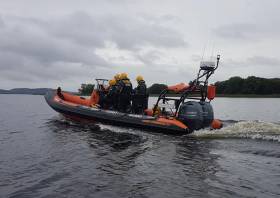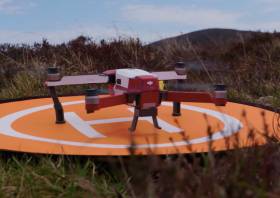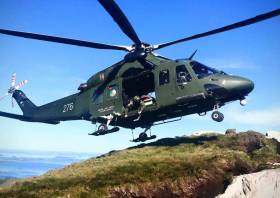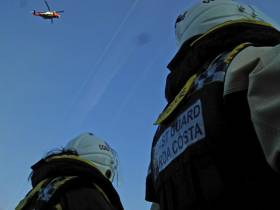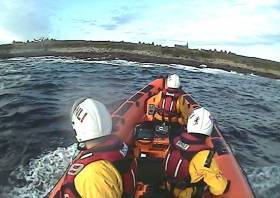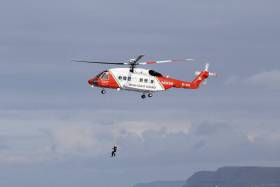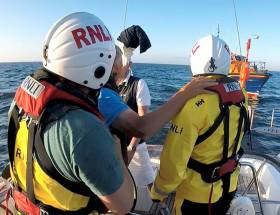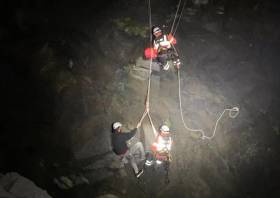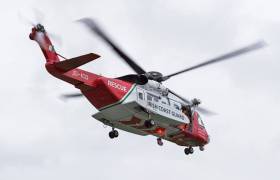Displaying items by tag: Irish Coast Guard
It’s hoped that five of the 23 Irish Coast Guard units whose boats were pulled from service over lifejacket safety issues could resume operations within days, as BreakingNews.ie reports.
Last month all coastguard rescue boat operations were suspended as the IRCG launched a probe into a malfunction of its standard issue lifejackets.
Community rescue boats, RNLI lifeboats and the Naval Service were called upon to provide cover for the 23 stations around Ireland that have been affected. The suspension does not apply to the IRCG’s shoreline and cliff rescue teams.
Management has now told volunteers that a new lifejacket, the Crewsaver 380N, is being introduced on a phased basis to replace the potentially affected Rescue 400.
Subject to testing and other operational requirements, this could see rescue boats back in service at the ‘priority’ stations of Mulroy and Greencastle (Co Donegal), Drogheda and Kilkee as soon as this Thursday 5 December. BreakingNews.ie has more on the story HERE.
Dun Laoghaire Coastguard Chosen For Drone Operations On East Coast
The Irish Coast Guard’s Dun Laoghaire unit has been chosen to pilot drone operations covering the East sector.
Training is set to commence early in the new year using DroneSAR, a software platform developed by a Donegal-based team to employ commercially available drones as part of search and rescue missions.
Once this training has been completed, the coastguard crew say they will be available to assist with missing person searches.
The news comes just months after the UK’s Maritime and Coastguard Agency announced its own 12-month drone trial to support its search and rescue actions on the Essex coast.
Coastguard to Step In As State Air Ambulance Faces Disruption Over Staffing Problems
Extra pressure will be put on the Irish Coast Guard’s helicopter rescue services this winter as the State’s air ambulance plans to shut down for 16 days between now and next February.
As RTÉ News reports, “mounting staffing and training problems” will force the Air Corps to ground the Athlone-based AC112 air ambulance it has been using since 2012 for a total of 16 days — four each month from now until February.
The Department of Defence confirmed in a statement that the coastguard “will provide reserve cover to the national ambulance service” in line with the establishment of the Emergency Aeromedical Service (EAS) in 2015.
The Irish Community Rapid Response air ambulance based in Rathcoole, Co Cork will also be available “and the potential for it to provide increased support is also being explored”.
The statement added: “The priority is to provide the best service possible using all available resources during the four-day periods each month when the Air Corps are not available for EAS taskings.
“This interruption is regrettable but necessary from a safety and governance perspective.”
The coastguard’s helicopter fleet was previously trialled as an air ambulance service, and subsequently engaged in night-time cover.
But the arrangement was scaled back two years ago over concerns with pilot doing double duty for patient transfers.
Lifejacket Issues See Irish Coast Guard Boat Operations Suspended
All Irish Coast Guard rescue boat operations are suspended as of yesterday (Friday 15 November) as the organisation launches a probe into a malfunction in its standard issue lifejackets.
RTÉ News reports that the coastguard’s rescue boats in 23 stations around Ireland have been withdrawn from service amid concerns over the Rescue 400 lifejacket used by its personnel.
“Specifically, the 275N section of the lifejacket failed to fully function when activated,” said an email to IRCG officers in charge as seen by media yesterday.
The suspension does not affect the Irish Coast Guard’s shoreline and cliff rescue teams.
Community rescue boats, RNLI lifeboats and the Naval Service are reportedly providing on-the-water cover in affected areas.
Four Rescued From Co Sligo Island After Vessel Capsizes
Four people have been rescued from an island off the Sligo coast after their vessel washed up on rocks.
Bundoran RNLI’s volunteer crew launched to the incident at Inishmurray Island yesterday afternoon (Sunday 3 November) along with the Irish Coast Guard’s Sligo-based helicopter Rescue 118, which airlifted the casualties to hospital
The RNLI says the lifeboat made efforts to recover their boat from the rocks but due to a three-metre swell, it was decided to leave it in place.
Later, volunteer helm Rory O’Connor said: “The four casualties were lucky on this occasion and we are thankful that they alerted the coastguard when they did. This was another callout with a good outcome.”
A motorboat that became propped up on pot buoys in Baltimore Harbour at the weekend made a direct call for help to the local RNLI’s all-weather lifeboat which was returning to base nearby.
The incident occurred on Saturday evening (7 September) after the Baltimore lifeboat had just completed a training exercise with the Irish Coast Guard’s Waterford-based helicopter Rescue 117.
Lifeboat press officer Kate Callanan said: “The skipper of the motorboat realised immediately that he needed assistance and as he had been watching the lifeboat and helicopter demonstration minutes before, he knew that the quickest way to alert the lifeboat was to call them directly on channel 16 on his VHF.”
Within minutes the all-weather lifeboat — with coxswain Kieran Cotter, mechanic Cathal Cottrell and crew members Emma Lupton, Ronnie Carthy, David Ryan, Jim Griffiths, Ryan O’Mahony and Eoin Ryan — was alongside the 33ft motor vessel.
Another motorboat skippered by former lifeboat crewman Torsten Marten was also nearby at the time, and he was drafted to assist in transferring two lifeboat crew to the casualty vessel rather than having to launch the lifeboat’s Y-boat.
The casualty boat was then secured alongside the all-weather lifeboat and brought to the safety of Baltimore’s North Pier.
Callanan reminded all boaters: “It is vital for anyone going to sea to always carry a means of communication such as a mobile phone or VHF in order to raise the alarm should they require help.”
The callout came on the eve of Baltimore RNLI’s centenary celebration yesterday (Sunday 8 September), at which it named its new Atlantic 85 inshore vessel 100 years to the date since the arrival of its first ever lifeboat.
Elsewhere, Skerries RNLI launched on Thursday night (5 September) to tow a razor fishing boat with two on board that struck rocks off Red Island and damaged its steering.
Irish Coast Guard Rescues 15 From Sea In Donegal
RTÉ News reports that 15 young people were rescued from the sea off Donegal yesterday afternoon (Tuesday 13 August).
Ten were airlifted to hospital in Letterkenny after the group got into difficulty while swimming by the pier at Magheroarty in north-west Donegal, according to the Irish Coast Guard.
Several emergency calls were reportedly made by onlookers at the scene, where the Mulroy coastguard unit and Tory Island ferry Queen of Aran also stood by to assist.
A spokesperson for the Irish Coast Guard acknowledged the fortunate outcome, and singled out the crew of the Sligo-based SAR helicopter Rescue 118 “for their efficient response to a difficult challenge”.
A man was taken to hospital with hand injuries by Irish Coast Guard helicopter after a Mayday call on a yacht off Kilmore Quay on Saturday (29 June).
The local RNLI lifeboat crew were en route to another vessel that had requested a tow when the call came in from a 12m yacht some 13 miles south-west of the Co Wexford village.
It was reported that as the yacht’s crew were adjusting a sail, a piece of rigging had parted and seriously injured the skipper’s hand.
The lifeboat arrived just after the Waterford-based coastguard helicopter Rescue 117, whose crew determined the best course of action was to transfer the casualty to the lifeboat for pain relief.
He was subsequently winched to the helicopter and flown to Waterford University Hospital for further treatment.
Greencastle, Co Donegal’s Irish Coast Guard team were tasked by the IRCG emergency operations centre at Malin to a rock climber who got into difficulty at Hell’s Hole on Malin Head on Tuesday evening (28 May)
The climber was trapped 45 metres down the cliff in a dangerous location, the cliff face being unpredictable with loose rocks and particularly so during hours of darkness.
Despite these challenges, the coastguard cliff team successfully rescued the climber.
If you see someone in difficulty, on the cliffs, coast or water, do not hesitate to dial 112 or 999 and ask for the coastguard.
Warnings After Laser Light Strikes Coastguard Helicopter
The Irish Coast Guard has warned over the dangers of laser pointers after a rescue helicopter was targeted during a training operation on Tuesday evening (28 May).
According to TheJournal.ie, Rescue 115 was conducting manoeuvres north of Doolin at around 10.18pm when the green laser light was flashed against the aircraft “multiple times”.
In this instance the flight was not interrupted, but gardaí are investigating and the coastguard has reiterated the dangers of flashing potentially blinding lights at any aircraft.
A recent spate of laser pointer incidents has been reported at Belfast International Airport. TheJournal.ie has more on that story HERE.


























